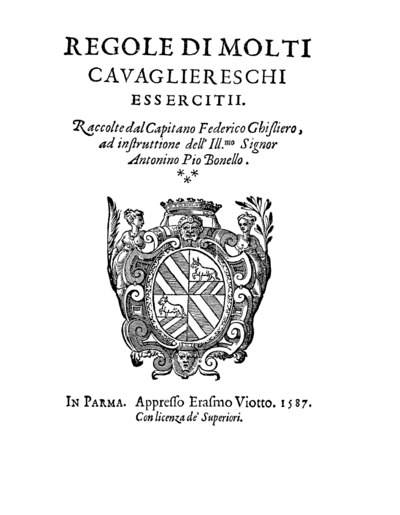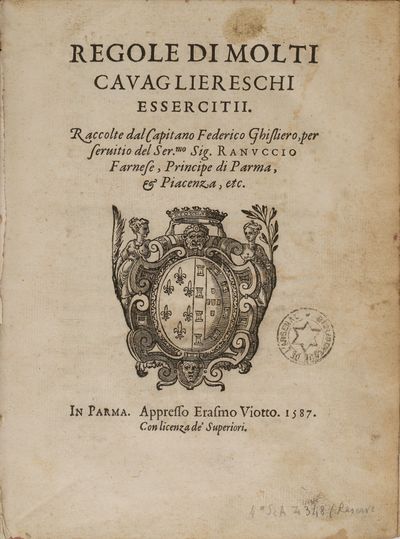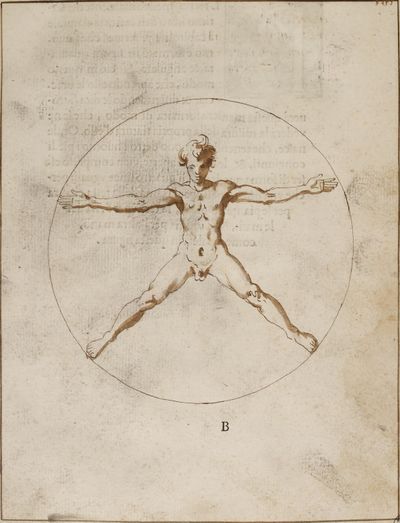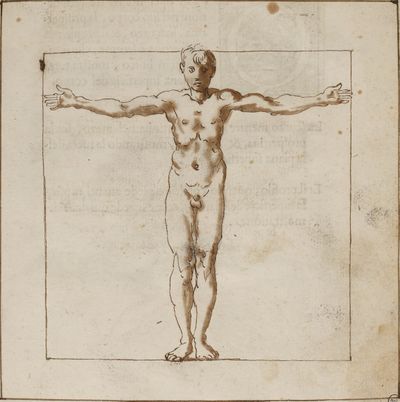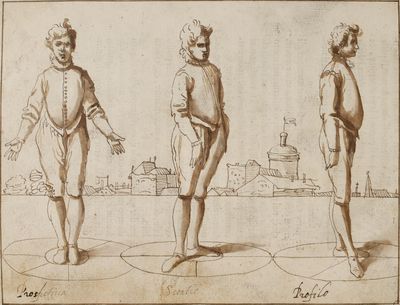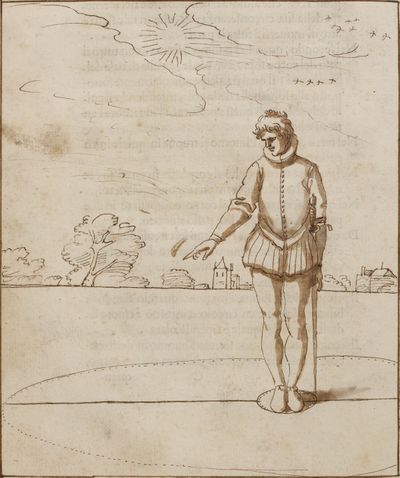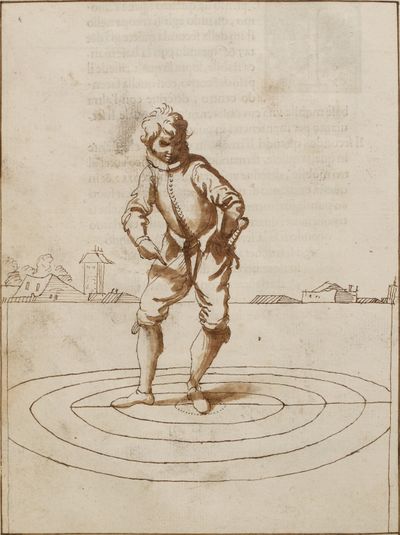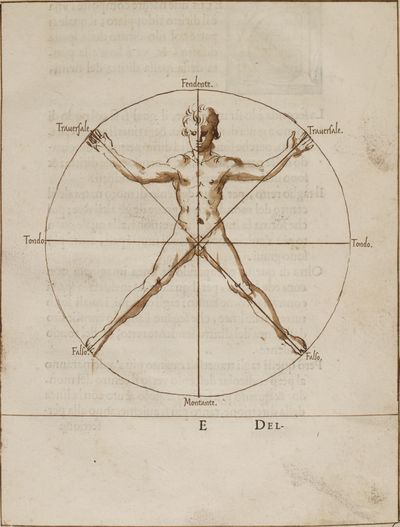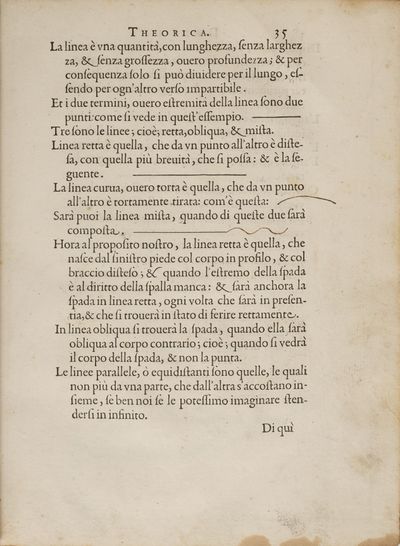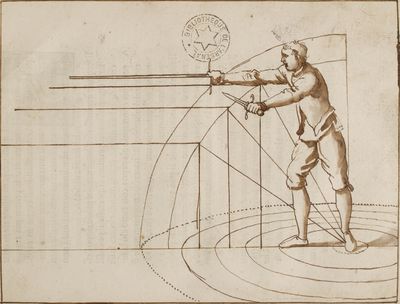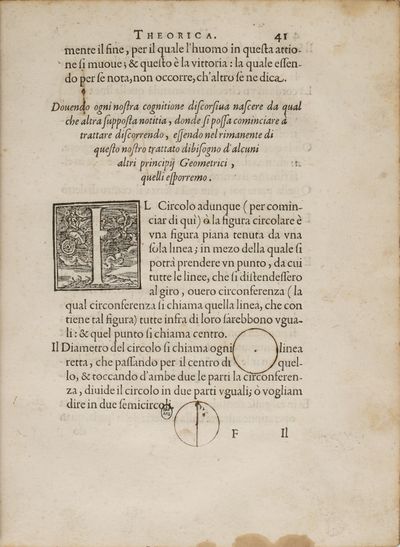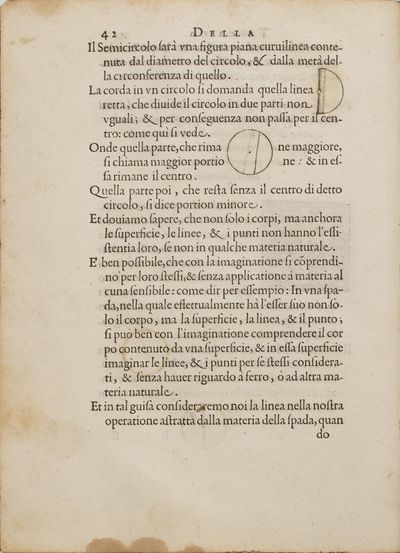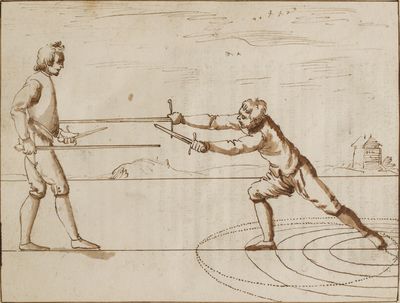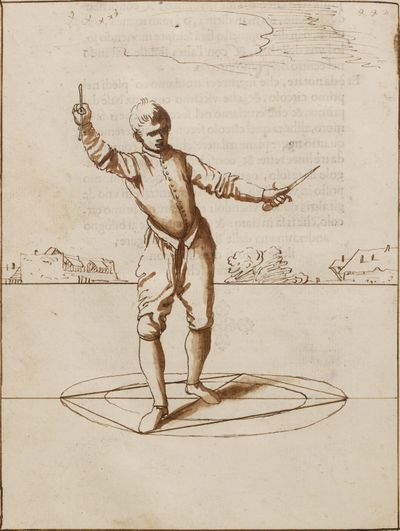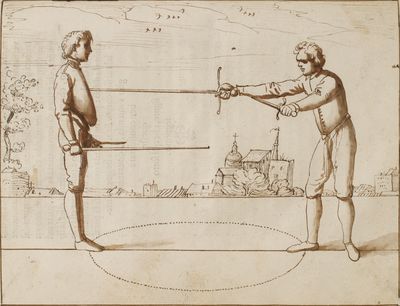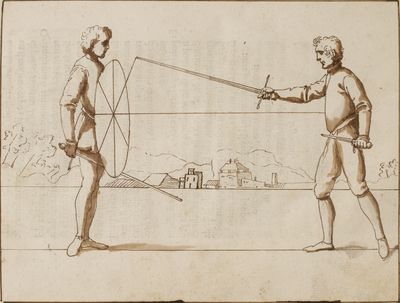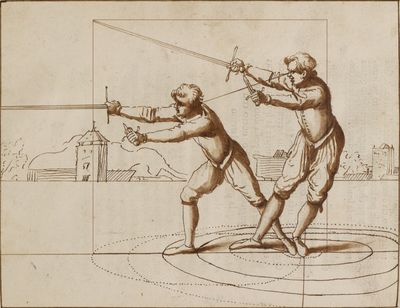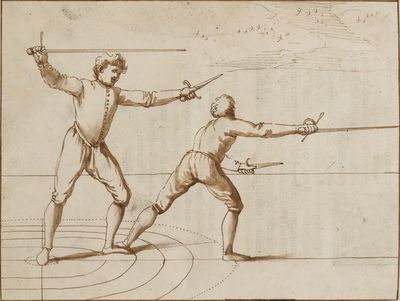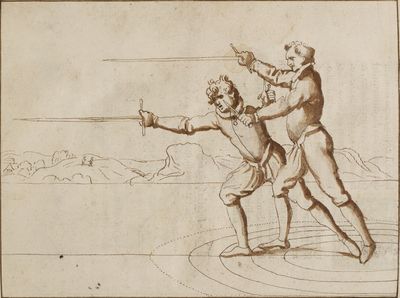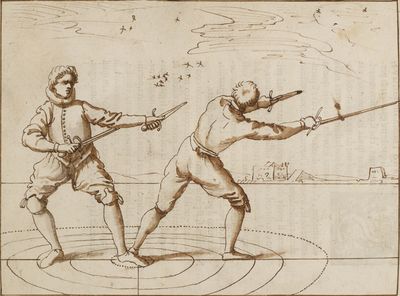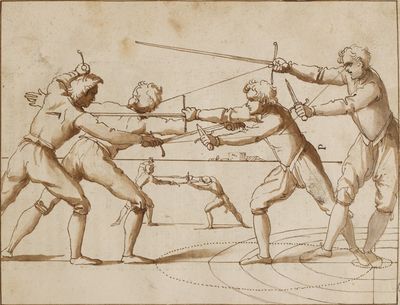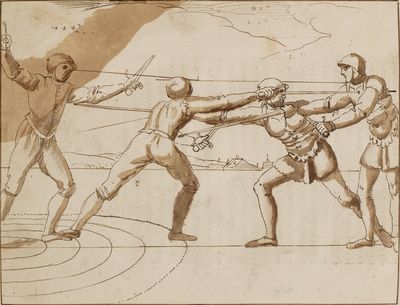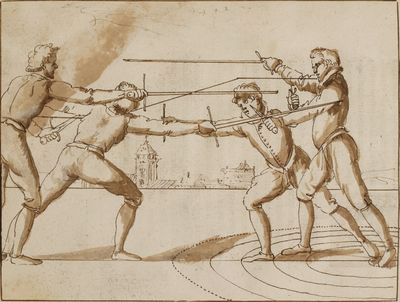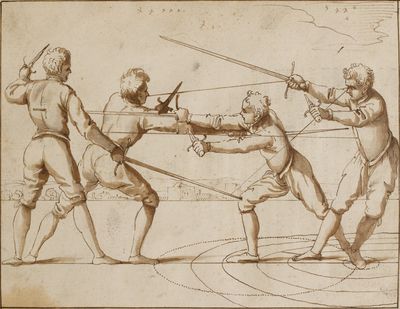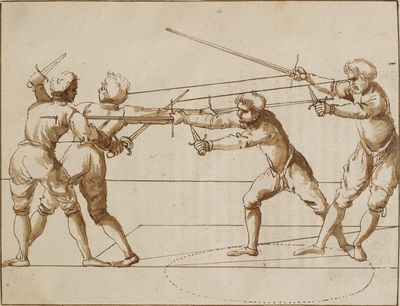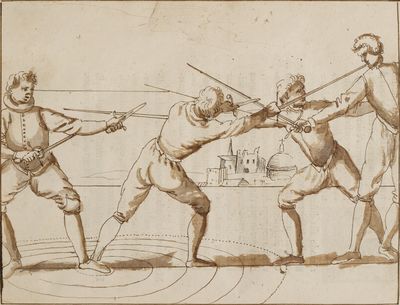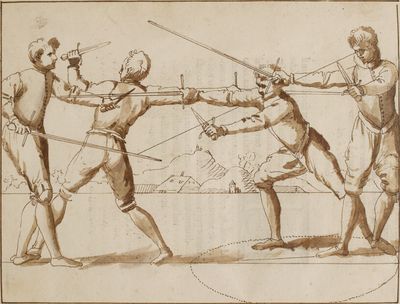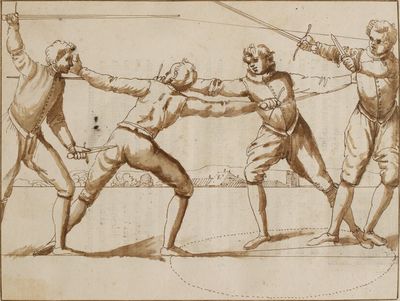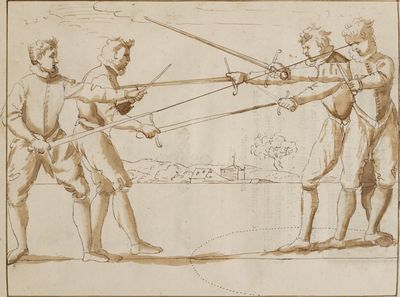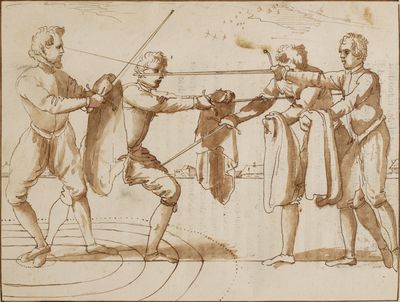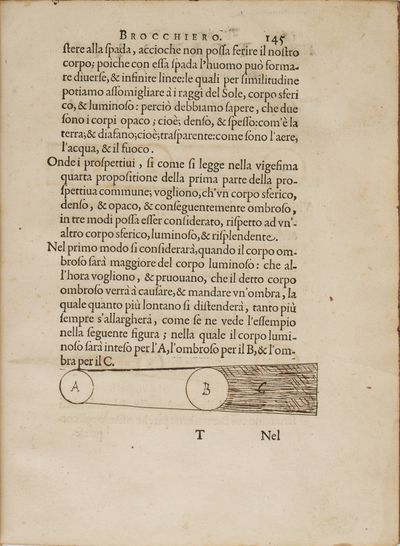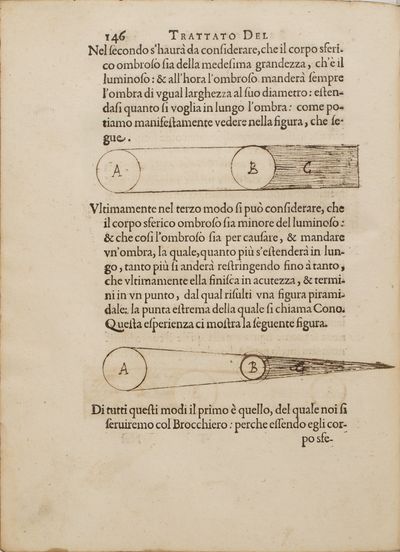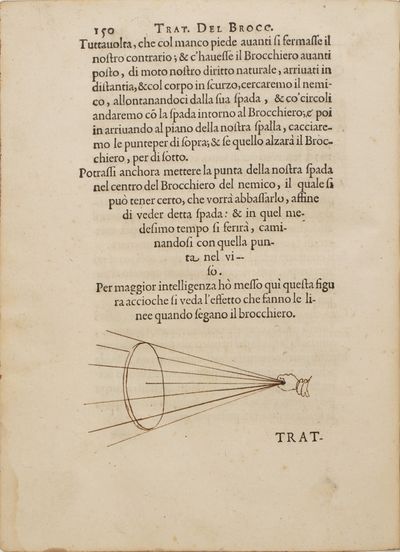|
|
You are not currently logged in. Are you accessing the unsecure (http) portal? Click here to switch to the secure portal. |
Difference between revisions of "Federico Ghisliero"
(→Temp) |
|||
| (7 intermediate revisions by the same user not shown) | |||
| Line 44: | Line 44: | ||
| below = | | below = | ||
}} | }} | ||
| − | '''Federico Ghisliero''' (d. 1619) was a Bolognese soldier and fencer. Little is know about his early life, but he came from a Bolognese family and studied fencing under [[Silvio Piccolomini]].<ref> | + | '''Federico Ghisliero''' (Ghislieri; d. 1619) was a Bolognese soldier and fencer. Little is know about his early life, but he came from a Bolognese family and studied fencing under [[Silvio Piccolomini]].<ref>Mentioned on [[https://wiktenauer.com/wiki/Page:Regole_di_molti_cavagliereschi_essercitii_(Federico_Ghisliero)_1587.pdf/10|p. +ⅱ]] of his dedication to Ranuccio and again on [[Page:Regole di molti cavagliereschi essercitii (Federico Ghisliero) 1587.pdf/108|p. 94]].</ref> He lead a long military career that included serving under the famous commander Alessandro, Duke of Parma, in Flanders in 1582. He was also a friend of Galileo Galilei and a prolific writer, though unfortunately most of his writings were destroyed in a fire at the University of Turin in 1904.<ref name="Anglo 30">Anglo 1994, p. 30.</ref> |
In 1587, he published a fencing treatise called ''[[Regole di molti cavagliereschi essercitii (Federico Ghisliero)|Regole di molti cavagliereschi essercitii]]'' ("Rules for Many Knightly Exercises"); two versions of the first edition exist, and it's unclear which was created first. One is dedicated to dedicated to Antonio Pio Bonello, a well-known soldier and distant relative, and the other to Ranuccio Farnese, who was 18 years old at the time and Alessandro's heir.<ref name="Anglo 30"/> | In 1587, he published a fencing treatise called ''[[Regole di molti cavagliereschi essercitii (Federico Ghisliero)|Regole di molti cavagliereschi essercitii]]'' ("Rules for Many Knightly Exercises"); two versions of the first edition exist, and it's unclear which was created first. One is dedicated to dedicated to Antonio Pio Bonello, a well-known soldier and distant relative, and the other to Ranuccio Farnese, who was 18 years old at the time and Alessandro's heir.<ref name="Anglo 30"/> | ||
| − | Ghisliero's treatise is notable for his use of geometry in relation to fencing, using concentric circles centered on where the fencer has placed most of their weight (often, but not always, the back foot), and sometimes including multiple versions of each figure in an illustration to show the progression of the movements he describes. He also seems to be the first author to | + | Ghisliero's treatise is notable for his use of geometry in relation to fencing, using concentric circles centered on where the fencer has placed most of their weight (often, but not always, the back foot), and sometimes including multiple versions of each figure in an illustration to show the progression of the movements he describes. He also seems to be the first author to reference the ''Vitruvian Man'' in a fencing treatise.<ref>See pp. 7-9. See also Gotti 2023, pp. 130-133.</ref> However, his treatise is unique in that it was printed without any illustrations at all, and they had to be drawn in by hand. It's unclear whether this indicates that he intended to have printing plates made but was unable to do so, or that his plan from the start was to have the books vary based on how much art each buyer was willing to pay for. |
Ghisliero died in Turino in 1619.<ref name="Anglo 30"/> | Ghisliero died in Turino in 1619.<ref name="Anglo 30"/> | ||
| Line 82: | Line 82: | ||
<p>'''F'''or ''two reasons, my Most Illustrious Sir, it has pleased me to direct to Your Most Illustriousness the present book of mine, which I have written here and now, and with good reason, on the use of arms. The first, so that with this new birth of mine I may wish you well, having intercepted with infinite pleasure the marriage which followed between you and the Most Illustrious Lady Octavia Bagliona: with which your Most Illustrious House may hope for a most happy succession: just as I desire that my birth, under the protection of your name, may live for a long time in safety. The other, so that by reading in this book, Your Illustriousness will be able to recognise in it those precepts, which perhaps up to now have been shown to you by a good Master in the handling of arms, your own virtue, which you have wished to adorn with many others in this most tender anchorage of yours. Therefore, let this effort of mine not be discouraging to you: for if it could be weak in itself, nevertheless, by reading it, Your Illustriousness will understand that you will be able to see much more than your own strength and merit would allow. I would like to thank Your Illustriousness for this letter. I kiss your hands.''</p> | <p>'''F'''or ''two reasons, my Most Illustrious Sir, it has pleased me to direct to Your Most Illustriousness the present book of mine, which I have written here and now, and with good reason, on the use of arms. The first, so that with this new birth of mine I may wish you well, having intercepted with infinite pleasure the marriage which followed between you and the Most Illustrious Lady Octavia Bagliona: with which your Most Illustrious House may hope for a most happy succession: just as I desire that my birth, under the protection of your name, may live for a long time in safety. The other, so that by reading in this book, Your Illustriousness will be able to recognise in it those precepts, which perhaps up to now have been shown to you by a good Master in the handling of arms, your own virtue, which you have wished to adorn with many others in this most tender anchorage of yours. Therefore, let this effort of mine not be discouraging to you: for if it could be weak in itself, nevertheless, by reading it, Your Illustriousness will understand that you will be able to see much more than your own strength and merit would allow. I would like to thank Your Illustriousness for this letter. I kiss your hands.''</p> | ||
| | | | ||
| − | {{paget|Page:Regole di molti cavagliereschi essercitii|I (alt)|png|lbl=+ⅱ|p=1}} {{section|Page:Regole di molti cavagliereschi essercitii II (alt).png|1|lbl=+ | + | {{paget|Page:Regole di molti cavagliereschi essercitii|I (alt)|png|lbl=+ⅱ|p=1}} {{section|Page:Regole di molti cavagliereschi essercitii II (alt).png|1|lbl=+ⅱ<sup>V</sup>.1|p=1}} |
|- | |- | ||
| Line 93: | Line 93: | ||
<p>   Federico Ghisliero. | <p>   Federico Ghisliero. | ||
| − | | class="noline" | {{section|Page:Regole di molti cavagliereschi essercitii II (alt).png|2|lbl=+ | + | | class="noline" | {{section|Page:Regole di molti cavagliereschi essercitii II (alt).png|2|lbl=+ⅱ<sup>V</sup>.2}} |
|} | |} | ||
| Line 122: | Line 122: | ||
<p>'''M'''''ost Gacious<ref>''La gratia'' is Catalan for "grace".</ref> and Serene Lord; when Your Highness reminded me of my service to you in the play of arms, that having worked with you only a little on one occasion; that I owed it to you to gather, almost in compendium, all about Theory and Practice. That I by showing in words, and by working with you struggled to obey you and to explain them. And I did that, not to believe that I will be perfectly aware of the profession of the use of arms (which is not really my profession, but is instead that of the military),<ref>Ghisliero is telling his reader that he is a soldier not a civilian swordsman, so it will have a different perspective to others, hence his later comments on siege craft. [note from Henry Fox]</ref> but by this means to show my gratitude to you. Because while I am deficient in many ways, if I may venture to be very brave, and rejoice very much, I have been noticed by the most illustrious Lord Silvio Piccolomini, for whom, and I hope always to show, that I owe the greatest gratitude to His Highness. How could I ever repay the receipt of this notice from? Even if I did, would I have put enough effort into the following work to warrant further regard from you?''</p> | <p>'''M'''''ost Gacious<ref>''La gratia'' is Catalan for "grace".</ref> and Serene Lord; when Your Highness reminded me of my service to you in the play of arms, that having worked with you only a little on one occasion; that I owed it to you to gather, almost in compendium, all about Theory and Practice. That I by showing in words, and by working with you struggled to obey you and to explain them. And I did that, not to believe that I will be perfectly aware of the profession of the use of arms (which is not really my profession, but is instead that of the military),<ref>Ghisliero is telling his reader that he is a soldier not a civilian swordsman, so it will have a different perspective to others, hence his later comments on siege craft. [note from Henry Fox]</ref> but by this means to show my gratitude to you. Because while I am deficient in many ways, if I may venture to be very brave, and rejoice very much, I have been noticed by the most illustrious Lord Silvio Piccolomini, for whom, and I hope always to show, that I owe the greatest gratitude to His Highness. How could I ever repay the receipt of this notice from? Even if I did, would I have put enough effort into the following work to warrant further regard from you?''</p> | ||
| | | | ||
| − | {{pagetb|Page:Regole di molti cavagliereschi essercitii (Federico Ghisliero) 1587.pdf|9|lbl=+ⅱ|p=1}} {{section|Page:Regole di molti cavagliereschi essercitii (Federico Ghisliero) 1587.pdf/10|1|lbl=+ | + | {{pagetb|Page:Regole di molti cavagliereschi essercitii (Federico Ghisliero) 1587.pdf|9|lbl=+ⅱ|p=1}} {{section|Page:Regole di molti cavagliereschi essercitii (Federico Ghisliero) 1587.pdf/10|1|lbl=+ⅱ<sup>V</sup>.1|p=1}} |
|- | |- | ||
| | | | ||
| <p>''I wish to provide you a sign of my loving inclination to you and that I will forever serve you in my life through this work.''</p> | | <p>''I wish to provide you a sign of my loving inclination to you and that I will forever serve you in my life through this work.''</p> | ||
| − | | {{section|Page:Regole di molti cavagliereschi essercitii (Federico Ghisliero) 1587.pdf/10|2|lbl=+ | + | | {{section|Page:Regole di molti cavagliereschi essercitii (Federico Ghisliero) 1587.pdf/10|2|lbl=+ⅱ<sup>V</sup>.2}} |
|- | |- | ||
| Line 133: | Line 133: | ||
| <p>''I add to this an ardent desire, which I too have together with your other faithful servants. Who is in this first flower of his age to want to provide to you the opportunity, which likewise from me can give you occasion, with this way shown by me, to become accustomed to the exercise: to your profit, and in a way that always protects your life and reassures those who worry about you.''<ref>This and the previous paragraph are commending the work to the patron, justifying the work’s existence and its purpose, common in treatises of the period. [note from Henry Fox]</ref></p> | | <p>''I add to this an ardent desire, which I too have together with your other faithful servants. Who is in this first flower of his age to want to provide to you the opportunity, which likewise from me can give you occasion, with this way shown by me, to become accustomed to the exercise: to your profit, and in a way that always protects your life and reassures those who worry about you.''<ref>This and the previous paragraph are commending the work to the patron, justifying the work’s existence and its purpose, common in treatises of the period. [note from Henry Fox]</ref></p> | ||
| | | | ||
| − | {{section|Page:Regole di molti cavagliereschi essercitii (Federico Ghisliero) 1587.pdf/10|3|lbl=+ | + | {{section|Page:Regole di molti cavagliereschi essercitii (Federico Ghisliero) 1587.pdf/10|3|lbl=+ⅱ<sup>V</sup>.3|p=1}} {{section|Page:Regole di molti cavagliereschi essercitii (Federico Ghisliero) 1587.pdf/11|1|lbl=+ⅲ.1|p=1}} |
|- | |- | ||
| Line 149: | Line 149: | ||
| <p>''Therefore, Your Highness, in response to your kindness, what is most dear to me, and for your own good, this effort of mine to deliver to you the dearest of desires which can be achieved; the preservation of life, and the recreation of the mind.''</p> | | <p>''Therefore, Your Highness, in response to your kindness, what is most dear to me, and for your own good, this effort of mine to deliver to you the dearest of desires which can be achieved; the preservation of life, and the recreation of the mind.''</p> | ||
| | | | ||
| − | {{section|Page:Regole di molti cavagliereschi essercitii (Federico Ghisliero) 1587.pdf/11|4|lbl=+ⅲ.4|p=1}} {{section|Page:Regole di molti cavagliereschi essercitii (Federico Ghisliero) 1587.pdf/12|1|lbl=+ | + | {{section|Page:Regole di molti cavagliereschi essercitii (Federico Ghisliero) 1587.pdf/11|4|lbl=+ⅲ.4|p=1}} {{section|Page:Regole di molti cavagliereschi essercitii (Federico Ghisliero) 1587.pdf/12|1|lbl=+ⅲ<sup>V</sup>.1|p=1}} |
|- | |- | ||
| | | | ||
| <p>''And the more willing you are to accept this gift of mine accompanied by very loyal advice (with which you may not always agree) that I do so with the example of the most serene Lord Duke A''<small>LESSANDRO</small>'', your father, which at the same age as Your Highness had spent time on this honourable pursuit and whose great name is well known. While his quality and greatness of name is not yet known to Flanders, all of Italy and almost all of the world is amazed at its incomparable value.''</p> | | <p>''And the more willing you are to accept this gift of mine accompanied by very loyal advice (with which you may not always agree) that I do so with the example of the most serene Lord Duke A''<small>LESSANDRO</small>'', your father, which at the same age as Your Highness had spent time on this honourable pursuit and whose great name is well known. While his quality and greatness of name is not yet known to Flanders, all of Italy and almost all of the world is amazed at its incomparable value.''</p> | ||
| − | | {{section|Page:Regole di molti cavagliereschi essercitii (Federico Ghisliero) 1587.pdf/12|2|lbl=+ | + | | {{section|Page:Regole di molti cavagliereschi essercitii (Federico Ghisliero) 1587.pdf/12|2|lbl=+ⅲ<sup>V</sup>.2}} |
|- | |- | ||
| | | | ||
| <p>''The principles of such greatness in Your Highness will no doubt be reflected in your and everyone hopes to see you walk in his footsteps to be just as great as him.''</p> | | <p>''The principles of such greatness in Your Highness will no doubt be reflected in your and everyone hopes to see you walk in his footsteps to be just as great as him.''</p> | ||
| − | | {{section|Page:Regole di molti cavagliereschi essercitii (Federico Ghisliero) 1587.pdf/12|3|lbl=+ | + | | {{section|Page:Regole di molti cavagliereschi essercitii (Federico Ghisliero) 1587.pdf/12|3|lbl=+ⅲ<sup>V</sup>.3}} |
|- | |- | ||
| Line 165: | Line 165: | ||
| <p>''I am grateful to be abundantly committed to the serenity of your person and willing to help you through to this end. I kiss your hands with humble reverence.''</p> | | <p>''I am grateful to be abundantly committed to the serenity of your person and willing to help you through to this end. I kiss your hands with humble reverence.''</p> | ||
| | | | ||
| − | {{section|Page:Regole di molti cavagliereschi essercitii (Federico Ghisliero) 1587.pdf/12|4|lbl=+ | + | {{section|Page:Regole di molti cavagliereschi essercitii (Federico Ghisliero) 1587.pdf/12|4|lbl=+ⅲ<sup>V</sup>.4|p=1}} {{section|Page:Regole di molti cavagliereschi essercitii (Federico Ghisliero) 1587.pdf/13|1|lbl=+ⅳ.1|p=1}} |
|- | |- | ||
| Line 2,531: | Line 2,531: | ||
|- | |- | ||
| − | | | + | | class="noline" | |
| − | | <p>Whenever we agree with our posture, if the enemy withdraws (which is mostly the case), we will lower our weapons and begin the fight again in the same way: and if we seem to be on our guard, we will reduce the enemy as much as we can, putting him in need.</p> | + | | class="noline" | <p>Whenever we agree with our posture, if the enemy withdraws (which is mostly the case), we will lower our weapons and begin the fight again in the same way: and if we seem to be on our guard, we will reduce the enemy as much as we can, putting him in need.</p> |
| − | | {{section|Page:Regole di molti cavagliereschi essercitii (Federico Ghisliero) 1587.pdf/149|4|lbl=135.4}} | + | | class="noline" | {{section|Page:Regole di molti cavagliereschi essercitii (Federico Ghisliero) 1587.pdf/149|4|lbl=135.4}} |
|} | |} | ||
| Line 2,556: | Line 2,556: | ||
|- | |- | ||
| − | | | + | | class="noline" | |
| − | | <p>If, by pulling on an attack, we come to half a sword, we will free ours; if we hold it inward, we will pull it upward, piercing the attack: and with our left hand we will catch the opposite sword in its hilt. But if we have it on the other side, we will take it out from underneath, drawing it into the angle formed by the two swords with our left arm crossed in defense; and we will attack with the point of the sword’s fist<ref>‘A reference to the ‘sword fist’ is made in [[Antonio Manciolino]]’s Opera Nova where it states “Of the narrow iron gate guard. The sixth guard is called “porta di ferro stretta”. In which the body must be arranged diagonally in such fashion that the right shoulder (as is said above) faces the enemy, but both the arms must be stretched out to encounter the enemy, so that the sword arm is extended straight down in the defense of the right knee, and so that the sword fist be near and centered on the aforesaid knee.” (Wiktenauer, 2022) It is then clear that ‘sword’s fist’ means the hand holding the hilt of the sword.</ref> upwards.</p> | + | | class="noline" | <p>If, by pulling on an attack, we come to half a sword, we will free ours; if we hold it inward, we will pull it upward, piercing the attack: and with our left hand we will catch the opposite sword in its hilt. But if we have it on the other side, we will take it out from underneath, drawing it into the angle formed by the two swords with our left arm crossed in defense; and we will attack with the point of the sword’s fist<ref>‘A reference to the ‘sword fist’ is made in [[Antonio Manciolino]]’s Opera Nova where it states “Of the narrow iron gate guard. The sixth guard is called “porta di ferro stretta”. In which the body must be arranged diagonally in such fashion that the right shoulder (as is said above) faces the enemy, but both the arms must be stretched out to encounter the enemy, so that the sword arm is extended straight down in the defense of the right knee, and so that the sword fist be near and centered on the aforesaid knee.” (Wiktenauer, 2022) It is then clear that ‘sword’s fist’ means the hand holding the hilt of the sword.</ref> upwards.</p> |
| − | | {{section|Page:Regole di molti cavagliereschi essercitii (Federico Ghisliero) 1587.pdf/150|2|lbl=136.2}} | + | | class="noline" | {{section|Page:Regole di molti cavagliereschi essercitii (Federico Ghisliero) 1587.pdf/150|2|lbl=136.2}} |
|} | |} | ||
| Line 2,641: | Line 2,641: | ||
|- | |- | ||
| | | | ||
| − | | <p>We must remedy the enemy’s attack with our sword, so that we can be sure of the attack outside of this tempo: and if we were to attack the enemy by chance at that time, it would be drawn in part, where the enemy’s cloak would entangle and impede our sword so that we would not recover it in time. Therefore, by securing ourselves against the enemy’s attack, we shall attack him secondarily in his right parts.</p> | + | | <p>We must remedy the enemy’s attack with our sword, so that we can be sure of the attack outside of this ''tempo'': and if we were to attack the enemy by chance at that time, it would be drawn in part, where the enemy’s cloak would entangle and impede our sword so that we would not recover it in time. Therefore, by securing ourselves against the enemy’s attack, we shall attack him secondarily in his right parts.</p> |
| {{section|Page:Regole di molti cavagliereschi essercitii (Federico Ghisliero) 1587.pdf/154|4|lbl=140.4}} | | {{section|Page:Regole di molti cavagliereschi essercitii (Federico Ghisliero) 1587.pdf/154|4|lbl=140.4}} | ||
| Line 2,665: | Line 2,665: | ||
|- | |- | ||
| − | | | + | | class="noline" | |
| − | | <p>If, however, he should try with his left foot to strike our sword with his cloak, we shall return with our left foot to the centre, and go out to the first of the four guards we have proposed; and with that fist we shall attack with the point or the cut, or above, passing the point and entering the face.</p> | + | | class="noline" | <p>If, however, he should try with his left foot to strike our sword with his cloak, we shall return with our left foot to the centre, and go out to the first of the four guards we have proposed; and with that fist we shall attack with the point or the cut, or above, passing the point and entering the face.</p> |
| − | | {{section|Page:Regole di molti cavagliereschi essercitii (Federico Ghisliero) 1587.pdf/157|3|lbl=142.3}} | + | | class="noline" | {{section|Page:Regole di molti cavagliereschi essercitii (Federico Ghisliero) 1587.pdf/157|3|lbl=142.3}} |
|} | |} | ||
{{master subsection end}} | {{master subsection end}} | ||
| − | |||
{{master subsection begin | {{master subsection begin | ||
| title = Chapter 20 - Treatise on the Buckler | | title = Chapter 20 - Treatise on the Buckler | ||
| Line 2,685: | Line 2,684: | ||
|- | |- | ||
| | | | ||
| + | | <p>'''Treatise on the Buckler'''</p> | ||
| + | |||
| + | <p>Many people have used the buckler in the same way as a dagger, and they have used it as a parry, accompanying it with the sword. However, since it is difficult for a man to show what he is capable of by means of some instrument, if he does not first make known what it belongs to, it is necessary, in order not to be mistaken, for them to know the quality and properties of the very instrument with which he intends to represent that essence. Since, therefore, we have to deal with the defensive instrument (as I said), we will begin by discussing it in this way.</p> | ||
| + | | {{section|Page:Regole di molti cavagliereschi essercitii (Federico Ghisliero) 1587.pdf/158|1|lbl=144.1}} | ||
| + | |||
| + | |- | ||
| + | | rowspan="3" | [[File:Ghisliero p145.jpg|400px|center]] | ||
| + | | <p>The buckler is a spherical, dense and opaque body, and in order for it to do its work properly, its surface must be less than a foot in diameter, since most men are a foot and a half wide: And because the effect of the buckler is to resist the sword, so that it cannot injure our body; since with this sword man can form different and infinite lines, which by similarity we can resemble the rays of the sun (a spherical and luminous body). Therefore we must know that there are two opaque bodies, that is to say, transparent: as are air, water and fire.</p> | ||
| + | | | ||
| + | {{section|Page:Regole di molti cavagliereschi essercitii (Federico Ghisliero) 1587.pdf/158|2|lbl=144.2|p=1}} {{section|Page:Regole di molti cavagliereschi essercitii (Federico Ghisliero) 1587.pdf/159|1|lbl=145.1|p=1}} | ||
| + | |||
| + | |- | ||
| + | | <p>Therefore perspective, as we read in the fourth proposition of the first part of the common perspective, wants a spherical, dense, opaque and consequently shadowy body to be considered in three ways with respect to another spherical, luminous and resplendent body.</p> | ||
| + | | {{section|Page:Regole di molti cavagliereschi essercitii (Federico Ghisliero) 1587.pdf/159|2|lbl=145.2}} | ||
| + | |||
| + | |- | ||
| + | | <p>In the first way it will be considered, when the shadowy body is greater than the luminous body,; for then they will desire and demand that the said shadowy body will cause and cast a shadow, which, the farther it extends, the more it will grow larger and larger, as is shown in the following figure, in which the luminous body is understood as A, the shadowy as B, and the shadowed as C.</p> | ||
| + | | {{section|Page:Regole di molti cavagliereschi essercitii (Federico Ghisliero) 1587.pdf/159|3|lbl=145.3}} | ||
| + | |||
| + | |- | ||
| + | | rowspan="3" | [[File:Ghisliero p146.jpg|400px|center]] | ||
| + | | <p>In the second, it must be considered that the spherical shadowed body is of the same size as the luminous one, and that the shadowed body will always send out a shadow of equal width to its diameter, and that the shadow may extend as far as one wishes, as we can clearly see in the following figure.</p> | ||
| + | | {{section|Page:Regole di molti cavagliereschi essercitii (Federico Ghisliero) 1587.pdf/160|1|lbl=146.1}} | ||
| + | |||
| + | |- | ||
| + | | <p>Lastly, in the third way, we may consider that the spherical shadowy body is smaller than the luminous one, and that the shadowy one is thus to cause and send a shadow, which, the longer it extends, the more it shrinks until it finally ends in sharpness and ends in a point from which a pyramidal figure emerges, the extreme point of which is called the Cone. This experience shows us the following figure.</p> | ||
| + | | {{section|Page:Regole di molti cavagliereschi essercitii (Federico Ghisliero) 1587.pdf/160|2|lbl=146.2}} | ||
| + | |||
| + | |- | ||
| + | | <p>Of all these ways, the first is the one which we will use with the buckler: because it is a spherical, opaque body, greater than the spherical, luminous body, or greater than the fist of the hand; from which, like the rays of the sun, arise the proportions of the lines which man forms with the sword, we will oppose it in such a way that it will cast a shadow, by which we will be covered and defended.</p> | ||
| | | | ||
| + | {{section|Page:Regole di molti cavagliereschi essercitii (Federico Ghisliero) 1587.pdf/160|3|lbl=146.3|p=1}} {{section|Page:Regole di molti cavagliereschi essercitii (Federico Ghisliero) 1587.pdf/161|1|lbl=147.1|p=1}} | ||
| + | |||
| + | |- | ||
| | | | ||
| + | | <p>However, we shall note that on this occasion the sword will have the opposite effect, specifically in a straight line or in power; i.e. in an oblique line. When it is in a straight line, we shall regard it as a single ray of the Sun, and we shall oppose it with the at the same point; but when it is oblique to our body, we shall oppose it using the buckler at the body of the fist at the origin of the ray, or of the line, so that we will be covered by the shadow of the opaque body of the buckler.</p> | ||
| + | | {{section|Page:Regole di molti cavagliereschi essercitii (Federico Ghisliero) 1587.pdf/161|2|lbl=147.2}} | ||
|- | |- | ||
| | | | ||
| + | | <p>And just as many straight lines, which come from a centre, the further they move away from that centre, the more they dilate among themselves: so, that if we use the buckler to oppose the sword, either the sword will get stuck in it, or it will cut it, so that it will move further away from its centre and from our body.</p> | ||
| + | | {{section|Page:Regole di molti cavagliereschi essercitii (Federico Ghisliero) 1587.pdf/161|3|lbl=147.3}} | ||
| + | |||
| + | |- | ||
| | | | ||
| + | | <p>It will therefore be held in the hand with the thumb resting on it: so that this part does not fall inwards: otherwise our body would be exposed and offended: and so that it will always operate as a blurred body, we will hold it with the arm outstretched: so that the greater shadow will be caused by its distance from our body.</p> | ||
| | | | ||
| + | {{section|Page:Regole di molti cavagliereschi essercitii (Federico Ghisliero) 1587.pdf/161|4|lbl=147.4|p=1}} {{section|Page:Regole di molti cavagliereschi essercitii (Federico Ghisliero) 1587.pdf/162|1|lbl=148.1|p=1}} | ||
|- | |- | ||
| | | | ||
| + | | <p>So that with this, as with all other kinds of defensive weapons, we shall operate by committing ourselves, without giving the enemy any intention of our will: distinguishing that the enemy will either be in motion or in a stationary state of mind.</p> | ||
| + | | {{section|Page:Regole di molti cavagliereschi essercitii (Federico Ghisliero) 1587.pdf/162|2|lbl=148.2}} | ||
| + | |||
| + | |- | ||
| | | | ||
| + | | <p>If the enemy is in motion, he will either use a slash or a thrust: we shall make the same parries and attacks to these slashes as we have said; but when we parry them with the buckler, we shall proceed with the accompanied arms; and we shall follow the centre of the fist and counterattack with the left foot.</p> | ||
| + | | {{section|Page:Regole di molti cavagliereschi essercitii (Federico Ghisliero) 1587.pdf/162|3|lbl=148.3}} | ||
| + | |||
| + | |- | ||
| | | | ||
| + | | <p>I leave it to say that we may injure before, during and after ''tempo'' in the same manner as we have said in the treatise on the sword and dagger, but we must always put the buckler behind the fist of our sword, stretching out the arm and body, and covering ourselves with it.</p> | ||
| + | | {{section|Page:Regole di molti cavagliereschi essercitii (Federico Ghisliero) 1587.pdf/162|4|lbl=148.4}} | ||
|- | |- | ||
| | | | ||
| + | | <p>If the opponent thrusts with the point, he can make the same attacks and parries that have already been said; but since things can easily be moved while they are in motion, the same defence can be made with the buckler as if it were a dagger.</p> | ||
| | | | ||
| + | {{section|Page:Regole di molti cavagliereschi essercitii (Federico Ghisliero) 1587.pdf/162|5|lbl=148.5|p=1}} {{section|Page:Regole di molti cavagliereschi essercitii (Federico Ghisliero) 1587.pdf/163|1|lbl=149.1|p=1}} | ||
| + | |||
| + | |- | ||
| | | | ||
| + | | <p>When the enemy is stationary, he may have his sword in front of him or behind him; if he has it in front of him or parallel with the ground in a straight line or at an angle.</p> | ||
| + | | {{section|Page:Regole di molti cavagliereschi essercitii (Federico Ghisliero) 1587.pdf/163|2|lbl=149.2}} | ||
|- | |- | ||
| | | | ||
| + | | <p>We shall oppose the buckler at the extreme point of each line, which will be high, and we shall pierce it underneath with our greatest length and in the same stroke.</p> | ||
| + | | {{section|Page:Regole di molti cavagliereschi essercitii (Federico Ghisliero) 1587.pdf/163|3|lbl=149.3}} | ||
| + | |||
| + | |- | ||
| | | | ||
| + | | <p>We shall oppose all straight lines which are at the right of the centre of our body (as in the case of the third and fourth guards) with the buckler at the extremity of the line; and above we shall put our sword to attack in a straight line.</p> | ||
| + | | {{section|Page:Regole di molti cavagliereschi essercitii (Federico Ghisliero) 1587.pdf/163|4|lbl=149.4}} | ||
| + | |||
| + | |- | ||
| + | | | ||
| + | | <p>If, on the other hand, he holds his sword at an angle to our body, he will place the scabbard against his fist; and with the same stroke he will attack the nearest place above.<p> | ||
| + | | {{section|Page:Regole di molti cavagliereschi essercitii (Federico Ghisliero) 1587.pdf/163|5|lbl=149.5}} | ||
| + | |||
| + | |- | ||
| + | | | ||
| + | | <p>If the opposite party holds the sword at an angle, the same offence will be carried out as if we had the dagger, helping the enemy’s sword to its inclination.</p> | ||
| + | | {{section|Page:Regole di molti cavagliereschi essercitii (Federico Ghisliero) 1587.pdf/163|6|lbl=149.6}} | ||
| + | |||
| + | |- | ||
| + | | | ||
| + | | <p>If we make the opposite move with the sword to the rear, we will seek out the enemy’s body in the aforesaid manner, and we will hold the buckler above our body in order to strike it, as if it were a dagger, thus necessitating the opposite sword to pass through it.</p> | ||
| + | | {{section|Page:Regole di molti cavagliereschi essercitii (Federico Ghisliero) 1587.pdf/163|7|lbl=149.7}} | ||
| + | |||
| + | |- | ||
| + | | rowspan="4" class="noline" | [[File:Ghisliero p150.jpg|400px|center]] | ||
| + | | <p>When we have stopped our opponent with our left foot in front and the buckler has been placed in front of us, we will, in our natural right hand, once we have arrived at a distance, and with our body in a dark position, seek out the enemy, moving away from his sword, and with our circles we will move the sword around the buckler, and then, arriving at the plane of our shoulder, we will throw our points upwards; and if he raises his buckler, we will do so below.</p> | ||
| + | | {{section|Page:Regole di molti cavagliereschi essercitii (Federico Ghisliero) 1587.pdf/164|1|lbl=150.1}} | ||
| + | |||
| + | |- | ||
| + | | <p>We may also place the point of our sword in the centre of the enemy’s scabbard, who may be certain to lower it in order to see the sword, and at the same time to wound himself by walking with the point in his face.</p> | ||
| + | | {{section|Page:Regole di molti cavagliereschi essercitii (Federico Ghisliero) 1587.pdf/164|2|lbl=150.2}} | ||
| + | |||
| + | |- | ||
| + | | class="noline" | <p>For the sake of greater intelligence I have placed this figure here so that one may see the effect of the lines when they cut into the buckler.</p> | ||
| + | | class="noline" | {{section|Page:Regole di molti cavagliereschi essercitii (Federico Ghisliero) 1587.pdf/164|3|lbl=150.3}} | ||
| + | |||
| + | |- | ||
| + | | class="noline" | <p><br/><br/><br/></p> | ||
| + | | class="noline" | | ||
| + | |||
| + | |} | ||
| + | {{master subsection end}} | ||
| + | |||
| + | == Temp == | ||
| + | {{master subsection begin | ||
| + | | title = Chapter 21 - Treatise Against a Left-Handed Person | ||
| + | | width = 90em | ||
| + | }} | ||
| + | {| class="master" | ||
| + | |- | ||
| + | ! <p>Images</p> | ||
| + | ! <p>{{rating|C}}<br/>by [[Nicola Boyd]]</p> | ||
| + | ! <p>Transcription<br/>by [[Nicola Boyd]]</p> | ||
| + | |||
| + | |- | ||
| + | | | ||
| + | | <p>'''Treatise Against a Left-Handed Person'''<ref>Ghisliero assumes all fencers are right hand dominant in this treatise and writes as such.</ref></p> | ||
| + | |||
| + | <p>'''A'''ll the arguments of the single sword; of the sword and dagger; of the cloak; and of the buckler, serve the left-handed against the right-handed; as well as the right-handed against the left-handed. And the weapon of defence can serve no other purpose than to parry the blows, which are thrown from afar; & to close the line: because, when the right-handed man is fighting the left-handed man, both have their swords on one side and their bodies placed in such a way that all the points of their swords strike at an angle, so that they cannot be parried with a defensive weapon, and therefore they must be parried with the sword, since the weakness of the left-handed man’s sword will pass through the strength of the right-handed man’s sword.</p> | ||
| + | | {{section|Page:Regole di molti cavagliereschi essercitii (Federico Ghisliero) 1587.pdf/165|1|lbl=151.1}} | ||
| + | |||
| + | |- | ||
| + | | | ||
| + | | <p>Therefore, the right-handed sword should be held in such a way that it dominates the left-handed sword inwards; and with the body in profile and the good edge, it should drive the points to the nearest place to be attacked.</p> | ||
| + | | {{section|Page:Regole di molti cavagliereschi essercitii (Federico Ghisliero) 1587.pdf/165|2|lbl=151.2}} | ||
| + | |||
| + | |- | ||
| + | | | ||
| + | | <p>The right hand will never injure the left-hander from the inside; but if he is not in motion, he can be injured at that time.</p> | ||
| + | | {{section|Page:Regole di molti cavagliereschi essercitii (Federico Ghisliero) 1587.pdf/165|3|lbl=152.3}} | ||
| + | |||
| + | |- | ||
| + | | | ||
| + | | <p>The right-handed [person] must distinguish whether the left-handed person will hold his sword forward or backward; and will act against the left-handed person in the aforesaid manner; that is to say, dominating the sword when it moves forward, giving the left-handed person the power to attack in tempo; and when it moves backward, he will fight with his body ready to make the same attack, closing the way to the enemy’s sword with his defensive weapons.</p> | ||
| + | | {{section|Page:Regole di molti cavagliereschi essercitii (Federico Ghisliero) 1587.pdf/166|1|lbl=152.1}} | ||
| + | |||
| + | |- | ||
| | | | ||
| + | | <p>The right hand will allow all cuts to pass through, and will wound after the time of the slash; or it will help him to decline, and will attack backwards: it will also be able to parry covered, and will make all the same attacks, that we have said, that are made before the tempo.</p> | ||
| + | | {{section|Page:Regole di molti cavagliereschi essercitii (Federico Ghisliero) 1587.pdf/166|2|lbl=152.2}} | ||
| + | |||
| + | |} | ||
| + | {{master subsection end}} | ||
| + | == Temp == | ||
| + | {{master subsection begin | ||
| + | | title = Chapter 22 - Treatise Against a Left-Handed Person | ||
| + | | width = 90em | ||
| + | }} | ||
| + | {| class="master" | ||
| + | |- | ||
| + | ! <p>Images</p> | ||
| + | ! <p>{{rating|C}}<br/>by [[Nicola Boyd]]</p> | ||
| + | ! <p>Transcription<br/>by [[Nicola Boyd]]</p> | ||
|- | |- | ||
Revision as of 20:35, 24 March 2024
| Federico Ghisliero | |
|---|---|
| Died | 1619 Turino |
| Occupation | Soldier |
| Citizenship | Bologna |
| Influences | |
| Genres | Fencing manual |
| Language | Italian |
| Notable work(s) | Regole di molti cavagliereschi essercitii (1587) |
| Manuscript(s) | M.A.M. Ghisliero MS (1585) |
| Translations | Alternate English translation |
Federico Ghisliero (Ghislieri; d. 1619) was a Bolognese soldier and fencer. Little is know about his early life, but he came from a Bolognese family and studied fencing under Silvio Piccolomini.[1] He lead a long military career that included serving under the famous commander Alessandro, Duke of Parma, in Flanders in 1582. He was also a friend of Galileo Galilei and a prolific writer, though unfortunately most of his writings were destroyed in a fire at the University of Turin in 1904.[2]
In 1587, he published a fencing treatise called Regole di molti cavagliereschi essercitii ("Rules for Many Knightly Exercises"); two versions of the first edition exist, and it's unclear which was created first. One is dedicated to dedicated to Antonio Pio Bonello, a well-known soldier and distant relative, and the other to Ranuccio Farnese, who was 18 years old at the time and Alessandro's heir.[2]
Ghisliero's treatise is notable for his use of geometry in relation to fencing, using concentric circles centered on where the fencer has placed most of their weight (often, but not always, the back foot), and sometimes including multiple versions of each figure in an illustration to show the progression of the movements he describes. He also seems to be the first author to reference the Vitruvian Man in a fencing treatise.[3] However, his treatise is unique in that it was printed without any illustrations at all, and they had to be drawn in by hand. It's unclear whether this indicates that he intended to have printing plates made but was unable to do so, or that his plan from the start was to have the books vary based on how much art each buyer was willing to pay for.
Ghisliero died in Turino in 1619.[2]
Treatise
Temp
Temp
For further information, including transcription and translation notes, see the discussion page.
| Work | Author(s) | Source | License |
|---|---|---|---|
| Images | Bibliothèque nationale de France | ||
| Translation | Nicola Boyd | Rules of many knightly armies | |
| Transcription | Nicola Boyd | Index:Regole di molti cavagliereschi essercitii (Federico Ghisliero) |
Additional Resources
The following is a list of publications containing scans, transcriptions, and translations relevant to this article, as well as published peer-reviewed research.
- Anglo, Sydney (1994). "Sixteenth-century Italian drawings in Federico Ghisliero's Regole di molti cavagliereschi essercitii." Apollo 140(393): 29-36.
- Gotti, Roberto (2023). "The Dynamic Sphere: Thesis on the Third State of the Vitruvian Man." Martial Culture and Historical Martial Arts in Europe and Asia: 93-147. Ed. by Daniel Jaquet; Hing Chao and Loretta Kim. Springer.
References
- ↑ Mentioned on [+ⅱ] of his dedication to Ranuccio and again on p. 94.
- ↑ 2.0 2.1 2.2 Anglo 1994, p. 30.
- ↑ See pp. 7-9. See also Gotti 2023, pp. 130-133.
- ↑ 4.0 4.1 Cavagliereschi is Corsican for "chivalrous", while the Italian is "knightly".
- ↑ La gratia is Catalan for "grace".
- ↑ Ghisliero is telling his reader that he is a soldier not a civilian swordsman, so it will have a different perspective to others, hence his later comments on siege craft. [note from Henry Fox]
- ↑ This and the previous paragraph are commending the work to the patron, justifying the work’s existence and its purpose, common in treatises of the period. [note from Henry Fox]
- ↑ It was common to refer to “ancients” in the justification of the art of swordsmanship. [note from Henry Fox]
- ↑ When ‘this art’ or ‘the art’ is referenced it means the art of fencing. [More expansively the ars militari (military arts) or for the more classical, the Arts of Mars, of which swordsmanship falls within.] [note from Henry Fox]
- ↑ Further justification by demonstration of the benefits to those who practice the art in question, also common, especially referring to defense of the person and the realm. [note from Henry Fox]
- ↑ The version dedicated to Antonino instead reads "...for the instruction of the Most Illustrious Lord Antonio Pio Bonello".
- ↑ Cavalier – cavaliere – knights – so indicating the noble nature of the art which he is presenting. [note from Henry Fox]
- ↑ The Humours.
- ↑ Means sad.
- ↑ Means calm.
- ↑ Means optimistic.
- ↑ Means bad-tempered.
- ↑ Hot-tempered.
- ↑ Moti has a number of meanings in modern Italian aside from "motion", including "motorcycle, bike, watercraft, riot, scooter".
- ↑ The use of square brackets [] shows the insertion of the translator to aid in clarity of meaning throughout the document.
- ↑ Contextually, transportar is in modern Italian trasporto and has been translated such.
- ↑ Where the word operante which means the operator or the person taking action or more simply the will is used elsewhere, I translate it to fencer as operator has the wrong connotations in English for what Ghisliaro appears to wish to convey.
- ↑ This is an application of Aristotle’s Causes, in some ways more easily explained due to the application of the sword (though this could be my fencer’s brain), especially as it develops. Ghisliero uses seven rather than four as Aristotle does, or at least using the same method of explanation. [Henry Fox]
- ↑ The spelling of secóda is seconda in modern Italian. This shortening of words through the removal of ‘n’ is common in documents of the period.
- ↑ Public roads means the location is a public road.
- ↑ Of Vitruvius’ Ten Books on Architecture. [This same book is referenced in Thibault] [note from Henry Fox]
- ↑ Or capacity.
- ↑ Flavius Vegetius Renatus' On Roman Military Matters is likely the text to which he is referring. Which was a fourth century commentary on the training of Roman legions harking back to older methods. [note from Henry Fox]
- ↑ Onde is Catalan. It is dove in Italian. Both mean ‘where’ in English.
- ↑ A second century book written by a Roman in the Attica region which encompasses the city of Athens.
- ↑ Dodrans is a Latin contraction of de-quadrans which means “a whole unit less a quarter” or three-quarters.
- ↑ Referencing the ‘ancients’ for authority was commonly used by authors of the time to demonstrate their comprehensive knowledge of the subject. It is intended to add gravitas to the treatise.
- ↑ All’hora is Catalan. Modern Italian is al tempo.
- ↑ The Elder.
- ↑ Scriue is Catalan. Modern Italian is lui scrive.
- ↑ Scurzo, does not translate appropriately from Italian. As with a number of words in Ghisliero’s treatise, it is likely a Catalase word or a unique spelling. Analysis of other treaties such as Jarod Kirby’s Italian Rapier Combat (Kirby, 2004) shows the following two definitions, on page 14 of the text, of a similar sound word that is contextually a more likely approximation of what scurzo means; “Scanso, A voidance, any evasive manoeuvre that moves the body of the direct line” and “Scanso del pie dritto, A voidance made by moving the right foot slightly off the direct line while turning the body.” So for the purposes of this translation, scurzo will mean in this text the middle stance as shown in Figure 3, i.e. a partial voiding stance halfway between perspective and profile.
- ↑ "Perspective" means front facing forward.
- ↑ Also could be interpreted as "figure".
- ↑ George Silver’s theory of the time for the hand and foot from his 1599 text Paradoxes of Defense mirrors this framework. [note from Henry Fox] (Silver, 1599)
- ↑ Et is Latin for ‘and’ in English and e in Italian.
- ↑ This is not an exact translation – it is the best approximation based on context.
- ↑ Balancia translates into ‘balance’.
- ↑ Membro translates to ‘member’, but in English a better word is limb.
- ↑ ò á mano manca la fontanella directly translates to something like ‘the hand missing the fontanelle’. This made no contextual sense, so it has been translated to ‘from the fountain of the body’ as fonta can mean ‘source’ in modern Italian. In the it states that “Fontánella, a little fountaine. Also a fontanell or cauterie [something to cauterise wounds], or rowling [turning round about, whirling or turning round], used also for the chiefe vein of a man’s body.” (Florio, 1611)
- ↑ ‘Perspective’ is forward facing as can be seen in Figure 3.
- ↑ No good translation found, contextually translating spatio to ‘space’.
- ↑ Polykleitos's Doryphoros is an early example of this position called contrapposto. See https://en.wikipedia.org/wiki/Polykleitos for examples of sculptures with this stance. (Wikipeadia, 2021)
- ↑ Polykleitos wrote a lost treatise called ‘Artistic canons of body proportions’ in 5th Century Greece which provided a reference for standard body proportions. For more information https://en.wikipedia.org/wiki/Artistic_canons_of_body_proportions (Wikipeadia, 2021)
- ↑ The act or process of passing across, over, or through.
- ↑ Aristotle’s fifth book of the Physica, which considers how motion occurs. “Book V classifies four species of movement, depending on where the opposites are located. Movement categories include quantity (e.g. a change in dimensions, from great to small), quality (as for colours: from pale to dark), place (local movements generally go from up downwards and vice versa), or, more controversially, substance. In fact, substances do not have opposites, so it is inappropriate to say that something properly becomes, from not-man, man: generation and corruption are not kinesis in the full sense.” (Aristotle, Physica (Book 5), (384–322 BC) 2007) “Generally things which come to be, come to be in different ways: (1) by change of shape, as a statue; (2) by addition, as things which grow; (3) by taking away, as the Hermes from the stone; (4) by putting together, as a house; (5) by alteration, as things which ‘turn’ in respect of their material substance.” Book 1, Physica, Aristotle (Aristotle, Physica (Book 1), (384-322 BC) 2007)
- ↑ Change of shape.
- ↑ By addition or by growing.
- ↑ Also taking away or removing.
- ↑ Putting things together or building.
- ↑ Change of material substance or alteration of its substance.
- ↑ “Three kinds of motion - qualitative, quantitative, and local” Book 5, Physica, Aristotle (Aristotle, Physica (Book 5), (384–322 BC) 2007)
- ↑ This same concept is present in Chapter 5 ‘Of tempo’ in Ridolfo Capo Ferro da Cagli’s 1610 publication Gran Simulacro dell'Arte e dell'Uso della Scherma and can be translated into the actions of the fencer undertaking the correct movements - from ward (stillness) to attack or defence (movement) to ward (stillness) again. It propounds that the fencer should always end an action in a ward. The same concept is raised in Angelo Viggiani dal Montone’s 1551 (published 1575) text Lo Schermo d'Angelo Viggiani (Montone, 1575) and Antonio Manciolino’s 1531 Opera Nova (Manciolino, 1531).
- ↑ "Violence" in this instance means outside force or against nature. The same concepts of natural and violent actions are used in Iberian swordsmanship, and they take higher guards to take advantage of this principle. [note from Henry Fox]
- ↑ Springimento is likely Springáre means ‘yarke, kicke or winze’ (Florio, 1611). Which likely means in context a preparation or a marshalling of position prior to deployment.
- ↑ Fighting at the barriers was a form of tournament bout usually performed by armoured combatants in which: a fence, a barrier, was imposed between fencers, combatants fought over the fence, and blows below the waist did not count as tournament points. [note by Henry Fox]
- ↑ Bases mean "legs". I have used "legs" wherever relevant in the translation.
- ↑ “Lacertoi, the arme from the elbow to the pitch of the shoulder. Also the brawne of sinnewes or muskles of a mans armes or legges. Also a Lizard. Also a Muskle because it is like a Lizard. Also a certain disease in a harse amongs the muskles and sinnuewes. Also a fish that grunteth as a Hog. Some have taken it also for a makrell fish.” (Florio, 1611) Thus lacertoi will be translated as the arm from the elbow to the shoulder joint.
- ↑ Keeping the elbow near the body.
- ↑ “Rascetta, the wrist of one’s hand. Also a kind of fine silke-rash.” (Florio, 1611)
- ↑ Direct translation is ‘good blade’.
- ↑ Costa “the back of a knife or weapon.” (Florio, 1611) There isn’t a common English equivalent which is a single word.
- ↑ This is consistent with Giacomo di Grassi’s treatise Ragione di adoprar sicuramente l'Arme (Grassi, 1570) which states that there is more power existing at the circumference of a circle than there is closer to the centre. [note from Henry Fox]
- ↑ Debole refers to the half of the blade from tip of the blade to one third down towards the hilt.
- ↑ Forte refers to the first third of the blade from the hilt to towards the tip.
- ↑ Placing the edge over the debole like this is the basis of the Italian gaining stringere of the sword, or the Spanish atajo. It's used to close and control the line to prevent the opponent from hitting us. [Note by Táriq ibn Jelal ibn Ziyadatallah al-Naysábúrí]
- ↑ Here Ghisliero’s methods conforms to common Italian approaches of defence to: always counter an opponent’s attacks with consideration for returning the attack, always attack with concern for defence, and not attack unless secure against the opponent’s attack. [note from Henry Fox]
- ↑ Justifications for use of the cut seem to be relatively rare in fencing treatise of the time. Ghisliero’s justifications may even be unique. [note from Henry Fox]
- ↑ The same justification for the thrust is given for the thrust being used by the legionary with the gladius, remaining more covered and it being more deadly than the cut. [note from Henry Fox]
- ↑ Fendente means vertical cut.
- ↑ Traversale – transversal or diagonal cut [sometimes squalembrato for downward or falso if rising] [note from Henry Fox]
- ↑ Tondo – horizontal cut
- ↑ Dritti – straight/forward [forehand cut, or natural cut, sometimes called mandritta] [note from Henry Fox]
- ↑ Roversi – reverse [backhand or cross-wise cut] [note from Henry Fox]
- ↑ The division for the cuts on most diagrams usually go through the navel, or heart rather than the groin in most treatise of the period. [note from Henry Fox] Gérard Thibault d'Anvers’ 1630 treatise Academie de l'Espée ‘Book 1 – Tableau/Plate 2 – Comparing the ideal figure to a real Figure; Sword Scabbards’ shows the division at the naval (d'Anvers, Academie de l'Espée, 1630) – in the text it is found in the section that begins Pour venir à la Pratique de tout ce qui a efté discouru, or “To come to the Practice of all that has been discussed” (d'Anvers, Academie de l'Espée – Book 1 – Tableau/Plate 1 – Philosophical Discussion; Construction and Mathematics of the Circle; Concerning the Sword: Proper Length and Introduction explanation of the first plate., 1630). Salvator Fabris, in his 1606 text, Sienza e Pratica d’Arme also has an illustration in the section Discorso sopra laprima guardia formata nel cauare la spada del fodero or “Discourse in the first guard formed in pulling the sword from the scabbard” demonstrates the where cuts should be made and these also shows the division at the navel rather than the groin. (Fabris, 1606)
- ↑ Diritto ridoppiato literally means right redoubled or a falso traversale meaning a diagonal rising cut.
- ↑ Stramazzóne means a circular cut where the hand is the centre of rotation for the cut. [Note by Táriq ibn Jelal ibn Ziyadatallah al-Naysábúrí] Florio describes it as ‘Stramazzóne, a downe-right blow. Also a rap, a cuffe or wherret on the cheeke.” (Florio, 1611)
- ↑ ‘Molinello, or Molinelli means a circular cut. [Note by Táriq ibn Jelal ibn Ziyadatallah al-Naysábúrí] As an aside, the Molinello for flags described in Francesco Fernando Alfieri’s 1638 treatise La Bandiera “The molinello is delightful. To perform it comfortably, you should have the standard in your right hand. You complete a full turn above the head, then throw it up in the air, catching it around the middle of the standard as the figure shows. The molinello is then turned towards the rear foot. After several rotations, as the hand becomes fatigued, you should grip the butt of the flag with your other hand and repeat the same lesson, again throwing it in the air as described above.” (Alferi, 1638)
- ↑ ‘World’ is translated from the word Mondo which means “the world, the universe. Also, a Mound or Globe, as Princes hold in their hands. Also, cleane, cleansed, pure, neate, spotlesse, purged. Also, pared, pilled. Also, winnowed, &c. Also, as we say, a world, a multitude or great quantitie.’ (Florio, 1611)
- ↑ Fendente tondo means the upper half of the circle as shown in figure 6B. When speaking of the reverses, he is speaking of the lower half of the circle in figure 6B.
- ↑ ‘Segáre, to sawe. Also to part, to cut or devide through the middle.’ (Florio, 1611)
- ↑ ‘Riversa’ [singular] t de’roversi, which means ‘to turn around, a reversion, reverting, reverse or a backblow. A powering down or overwhelmed’ – in short the riversa is a back-hand. (Florio, 1611) Note how even the cut from the wrist is aided by motion of the body, no doubt using the feet to move the body as the cut is made as well, all in their correct motion, to affect the cut. [Note from Henry Fox]
- ↑ Imbroccata means a descending thrust. Stoccata, means a violent thrust ascending or rising. Punta riversa means a reverse thrust with the point of the sword.
- ↑ “Auentáta, a hurling, looke Auentáre.” (Florio, 1611) “Auentáre, to hurle, to fling, to dart or cast with violence. Also, to leape or seaze greedily upon, to souse downe as a hawke, also to fill or puff with winde.” (Florio 1611 Dictionary). Therefore imbroccata aventata or imbroccata aventate means to violently attack using a thrust of the rapier over the dagger.
- ↑ The first two lines on the page are printed, but the second two needed to be drawn in by the artist.
- ↑ Here the page numbers jump from 35 to 38, correcting the error of having two 32s and 33s
- ↑ This is the reason that the direct thrust from the shoulder in a straight line is the longest and most preferable and the reason to learn to thrust straight rather than aiming up toward the head. [Note by Henry Fox]
- ↑ 92.0 92.1 92.2 92.3 92.4 92.5 There is a gap in the text here for a circle to be drawn in.
- ↑ The effect of these causes is the fencer hitting their opponent using the technique. Poor technique means the fencer misses and/or dies.
- ↑ The material causes are the movements of the fencer’s body and sword.
- ↑ The formal cause is how the fencer uses the movements of the material cause.
- ↑ The factual cause is the fencer, with their measurements and proportions, and their ability to perform the material causes.
- ↑ The final cause is the actual technique the fencer is trying to achieve.
- ↑ Measure also often called distance. The measure of something is fluid due to the fencer’s, and their opponent’s, relative proportions in each combat and other considerations regarding weaponry. “The Spanish attempt to make it more certain by using proportionality, measuring against the length of the individual.” [note by Henry Fox] Gérard Thibault d'Anvers 1628 treatise Academie de l'Espée (d'Anvers, Academie de l'Espée, 1630) “…the Distances and Instances (i.e. steps in the process of fighting) to be observed in training (which are the basic foundations and support for all the following parts) proceed from the proportions of Man, therefore without this same awareness, they cannot be duly comprehended, nor practiced with confidence. And the same goes for the Steps and Approaches, short and long, required by the variety of positions in the performance of these Exercises. From which it is apparent that one must begin with a good knowledge of the proportion of limbs and body parts, that one may at least be able to make some reasonable judgement on the reach of each movement, proportionally to the limb, or limbs, on which the movement depends, and from which it must be continued, ended, turned, returned, released, bound, or changed in a thousand different ways.” (d'Anvers, Academie de l'Espée - – Book 1 – Tableau/Plate 1 –Philosophical Discussion; Construction and Mathematics of the Circle; Concerning the Sword: Proper Length and Introduction explanation of the first plate., 1630)
- ↑ Approximately 46 to 50 inches or 117cm to 127cm.
- ↑ Approximately 69 to 75 inches or 175cm to 191cm.
- ↑ Distance can be measured by Time, and Time measured by Distance so in effect one is the other, and every action toward or away from an opponent is measured in both Time and Distance; he seems to say much the same thing further along. [note by Henry Fox]
- ↑ Aristotelian motion is the consideration of “a stillness and motion” and is used by Capo Ferro as a method of reading the opponent in Chapter 5 ‘Of Tempo’ (Cagli’, 1610) [note by Henry Fox]
- ↑ Obligatory motion is the beginning of second intention. The fencer moves in a particular way so that the opponent has to do something in response, and then the fencer can follow on with their plan. [Note by Henry Fox]
- ↑ I will start using tempo from this point on instead of time when describing time as a measure of distance, to differentiate between it and the common use of the word time. Following Ghisliero’s explanation of tempo, it will be easier to use tempo to encapsulate this meaning.
- ↑ Sometimes extended to botta lunga, depending on the author [note by Henry Fox].
- ↑ “Attack into preparation” is what it is called in modern nomenclature, catching the opponent while they are preparing to act. [note by Henry Fox]
- ↑ An action in half-time, because the action is in motion, thus not completed, interrupted. [note by Henry Fox]
- ↑ This is an important note; the sword is extended and the fencer is covered by the extension of the sword in a straight line. [note from Henry Fox]
- ↑ Strongest third of the blade from the hilt toward the middle.
- ↑ Strongest third of the blade from the hilt toward the middle.
- ↑ Note the positions of the weapons relative to one another. This is consistent with the Aristotelian and the Iberian approaches. [note from Henry Fox]
- ↑ The position of the hand and blade position in this initial stage is vital to the techniques that will follow. [note from Henry Fox]
- ↑ This appears to be discussing taking the line or stringeri.
- ↑ A “reversed thrust” in this instance.
- ↑ ‘in presentia’ means the sword is on the line of engagement. [Note by Táriq ibn Jelal ibn Ziyadatallah al-Naysábúrí]
- ↑ This explains the advantages of Ghisliero’s guard position, demonstrating that the guard is the foundation of a fencing system. [note by Henry Fox]
- ↑ Punta scavizzata means hollow point.
- ↑ Gobba means hump or hunchback.
- ↑ Puinta riversa is a spelling variation from punta riversa.
- ↑ Incapocchiato does not translate, it suggests the word incapacitate. Incapocchiársi means ‘to become a doult or logger-head, to take a foolish conceite’ (Florio 1611) It might also mean encompassing in modern Italian.
- ↑ Guardia di falcone means "falcon’s guard". This is what the Bolognese authors call guardia alta. [Note by Táriq ibn Jelal ibn Ziyadatallah al-Naysábúrí]
- ↑ Coda longa, & larga or coda lunga e larga means "long and broad tail guard".
- ↑ scanso del corpo means void the body. Basically, these are the body turns we use to take the body off the line of engagement. [Note by Táriq ibn Jelal ibn Ziyadatallah al-Naysábúrí]
- ↑ Inquartata means quartering step. It is a voiding action of the body which closes the inside line.
- ↑ “Long and high tail” guard.
- ↑ The sequence of the combatant should always be ward – blow – ward, or stillness – motion – stillness, it is a common and practical method in quite a few treatises. [note from Henry Fox]
- ↑ Examine di Grassi’s (Grassi, 1570) diagram of the thrust and movement of the arm for an example of this motion. [note from Henry Fox]
- ↑ Nature means their passions.
- ↑ Parate – parade – often later used, especially in smallsword in place of ‘parry’. [note from Henry Fox]
- ↑ Mezzo mandritto means a half-leg cut.
- ↑ Mezzo riverso means a half-reversed cut.
- ↑ Garatusa is Spanish for thrust. In fencing it is a technique composed of nine movements, and the participation of two and three angles, that they make to [through, from] both parts [locations, sides], from the outside and from the inside, arrojando the sword with force to the sides, and from there they return to raise it [the sword] to wound with a thrust in the face or chest. It is not safe [sure]. (Ghost Sparrow Publications, 2021)
- ↑ Polykleitos's Doryphoros is an early example of this position called contrapposto. See https://en.wikipedia.org/wiki/Polykleitos for examples of sculptures with this stance. (Wikipeadia, 2021)
- ↑ Pili (pilum or pila) was the javelin of which the Romans were armed with two along with their sword. [note by Henry Fox]
- ↑ Cortina means a long wall running level from one bulwark to another.
- ↑ A strada coperta is a close walk or passage made on the top of a counter-scarpe in which the besieged may cover themselves from the enemies (Florio 1610)
- ↑ Archibuseria likely is an alternative spelling of archibugiera, which are a wall with slits, in a fortress, through which a weapon can be fired.
- ↑ Riverso traversale means a transverse or diagonal blow during retreat. “It’s equivalent to a riversa squalembrato or falso manco, depending on whether ascending or descending.” [note from Henry Fox]
- ↑ Imbroccata aventata means a hurling or forceful thrust given over the dagger.
- ↑ Gabionate fortifications or fences made of Gabions – cages or baskets full of earth set with ordinance to hide and defend Cannoniers. (Florio 1611)
- ↑ Trincerone means a large, well-equipped trench.
- ↑ No translation of this word is available.
- ↑ Manca means missing, and probably means back or voided leg.
- ↑ This probably means that the sword has mechanical advantage in a thrusting position.
- ↑ Corda means rope or cord, but in this context means the diameter of the circle.
- ↑ ‘A reference to the ‘sword fist’ is made in Antonio Manciolino’s Opera Nova where it states “Of the narrow iron gate guard. The sixth guard is called “porta di ferro stretta”. In which the body must be arranged diagonally in such fashion that the right shoulder (as is said above) faces the enemy, but both the arms must be stretched out to encounter the enemy, so that the sword arm is extended straight down in the defense of the right knee, and so that the sword fist be near and centered on the aforesaid knee.” (Wiktenauer, 2022) It is then clear that ‘sword’s fist’ means the hand holding the hilt of the sword.
- ↑ Cappa means both cloak and cape (there is no differentiation in Italian). I will use cloak for the purpose of consistency. The Spanish cloak or cape is short compared with what we normally consider to be a cloak. It is usually worn anywhere from below the shoulder blade length to the hip.
- ↑ Stringeremo appears to mean the same as stringere or a drawing close posture. Most commonly used as stringere la spada where using the stronger part of the sword you engage with the weaker part of the opponent’s sword and take the line or advantage so the point of the opponent’s sword can no longer strike you.
- ↑ Ghisliero assumes all fencers are right hand dominant in this treatise and writes as such.

